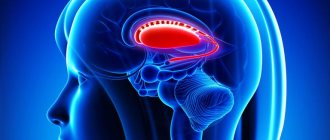Central and peripheral vestibular syndrome
Recently, interest in the problems of dizziness and balance disorders has increased significantly. This is due not only to the growing number of patients turning to doctors with similar complaints, but also to the emergence of new diagnostic methods, the creation of both specific pharmacological drugs and methods of rehabilitation therapy. A lecture on the topic of dizziness in the practice of a neurologist was held on April 13 and within the framework of the All-Russian educational Internet program for doctors. Natalya Stepanovna Alekseeva, Doctor of Medical Sciences, specialist at the Scientific Center of Neurology of the Russian Academy of Medical Sciences, spoke about the specifics of central and peripheral vestibular syndromes, which are characterized by symptoms of dizziness.
Classification of cochleovestibular disorders at different levels of damage:
1. Peripheral level
- Labyrinthine lesion
- Radicular lesion
2. Central level
- Subtentorial truncal lesion
- Supratentorial lesion
3. Combined level of damage
The main diseases that occur when vestibular formations are damaged at various levels:
Lesion: Peripheral receptor and vestibular nerve in the pyramid of the temporal bone (vestibular ganglion, nerve in the internal auditory canal).
Disease: Meniere's disease (hydropses of the endolymphatic sac); vascular disorders in the labyrinthine artery (LA); cracks of the pyramid of the temporal bone; neuritis of the vestibular portion of the VIII nerve; intoxication with ototoxic antibiotics; neurovascular conflict.
Lesion: Vestibular nerve in the cerebellopontine angle
Disease: Otogenic arachnoiditis of the cerebellopontine angle; neuritis of the vestibular portion of the VIII nerve; vascular disorders in the vertebrobasilar system (neurovascular conflict); intracanal neuromas of the VIII nerve.
Damage: Brain stem, cerebellum, IV ventricle.
Disease: Vascular disorders in the vertebrobasilar system (arterial hypertension, atherosclerosis, vascular thrombosis, hemorrhages, stroke); encephalitis; cerebellar tumors (angioreticularomas, astrocytomas), tumors of the fourth ventricle (choroid papillomas, ependymomas, cysticerci).
Damage : cerebral cortex.
Disease: Vestibular aura in the form of dizziness in temporal lobe epilepsy of tumor, inflammatory and vascular etiology.
Clinical example: central vestibular syndrome in a sick man with hypertension and atherosclerosis:
Mild manifestations of atherosclerosis in the form of thickening up to 1.1 mm. intima-media complex of both CCAs (common carotid artery) and a hemodynamically insignificant atherosclerotic plaque in the bifurcation of the left CCA and ICA (internal carotid artery, stenosis up to 30%), tortuosity of both ICAs, late entry of the left VA into the canal (at the C5 level). Clinical blood test shows hemoglobin 171.
Characteristics of peripheral vestibular syndrome:
- Nystagmus is often horizontal unilateral with a rotor component
- Vestibular disorders are accompanied by unilateral noise and hearing loss
- Decreased response to caloric test on the affected side
- No neurological symptoms
Differential diagnosis of PCVS (peripheral cochleovestibular syndromes) with other diseases:
- Bilateral vestibulopathy
- Meniere's disease
- Chronic otitis media, labyrinthitis
- Psychogenic dizziness
- TBI (traumatic brain injury)
- BPPV (benign paroxysmal positional vertigo)
Frequency of developmental anomalies of the vertebral arteries in patients with hypertension and peripheral dizziness ( N=60):
- Asymmetry of diameters – 36%
- Anomalies (hypoplasia) – 25%
- Deformations – 22%
- Anomalies of the entry of the vertebral artery into the canal – 9%
- Absence of posterior communicating arteries – 10%
Damage to the vestibular nerve in the cerebellopontine angle:
- Vascular disorders in the vertebrobasilar system - VBS (Meniere's syndrome)
- Neurovascular conflict
- Neuromas of the VIII nerve
- Arachnoiditis of the cerebellopontine angle
- Neuritis of the vestibular portion of the VIII nerve
Central vestibular syndrome:
- Dizziness due to imbalance
- Auditory symptoms are mild, or one-sided deafness occurs simultaneously with vestibular disorders
- Neurological symptoms are detected
- Structural changes in the vertebral arteries (stenosis, occlusion, dissection and deformation)
Conclusion: The otoneurological method diagnoses peripheral and central vestibular syndromes, and comparison of the results obtained with the state of blood flow in the vessels of the VBS according to ultrasound techniques, CT, and MRI allows us to identify the main pathogenetic mechanisms of their development, which is the key to successful pathogenetic therapy.
Read about the characteristics of dizziness in patients with arterial hypertension in the material “Dizziness: life-threatening?!”>>
Photo: https://zianarmie.wordpress.com
Therapeutic measures
Treatment for disorders of the vestibular system is prescribed in accordance with the results of diagnostic procedures and is a complex process involving the use of medications and physiotherapy.
Drug therapy
Medicines are used for symptomatic treatment. This is due to the fact that it is almost impossible to eliminate the dysfunction of the vestibular apparatus that provokes the syndrome with the help of drugs. Despite this, taking medications can significantly improve the patient’s condition and reduce the frequency and intensity of attacks.
Groups of drugs for the treatment of vestibular syndrome:
- antihistamines (“Tavegil”, “Diphenhydramine”);
- anticholinergics (“Atrovent”, “Platifillin”);
- antiemetics (“Cerucal”, “Meterazine”);
- nootropic drugs (“Piracem”, “Cavinton”).
Antispasmodics, sedatives and analgesics are also used for therapeutic purposes. They are recommended to be taken directly during an attack. In the absence of contraindications, the patient can use No-Shpu, Bellaspon, and Cinnarizine.
If the pathology is of infectious origin, antibiotics or antiviral agents are prescribed for therapeutic purposes. Before taking it, be sure to study the instructions for contraindications. Taking medications is permissible only in accordance with the prescribed dosages.
Physiotherapy
During the treatment period, the patient undergoes various physiotherapeutic procedures. They are aimed at overall strengthening of the body, restoring the functions of the inner ear, improving local blood circulation, eliminating dizziness and other symptoms of vestibular syndrome.
The procedures used include:
- mud therapy;
- acupuncture;
- hirudotherapy;
- acupressure head massage;
- magnetotherapy.
The patient is also recommended to follow a diet and lead an active lifestyle. It is imperative to give up bad habits and follow a daily routine.
Folk remedies
Alternative medicine methods are used for auxiliary purposes. Before using them, consultation with your doctor is required.
Effective recipes:
- Clover decoction. To prepare, pour 1 spoon of dried plant into a glass of boiling water and leave for 30 minutes. The resulting product is drunk 1/4 cup before each meal.
- Tea with sage. Plant raw materials (4 spoons) are placed in a container with 0.5 liters of boiling water and stirred thoroughly. The product is infused and then drunk instead of tea, preferably before meals. It is recommended to add honey to the drink.
- Parsley infusion. Parsley seeds are used for medicinal purposes. They are crushed using a coffee grinder and then brewed (1 spoon of powder per glass of boiling water). The resulting drink is taken 50 ml 4 times a day.
- Carrot juice. Used to eliminate dizziness and strengthen the immune system. It is necessary to drink 3 glasses of freshly squeezed juice throughout the day.
- Kelp. Used dry. To eliminate the symptoms of vestibular syndrome, it is enough to take 1 teaspoon with water.
Numerous traditional methods are used to treat vestibular disorders. It is important to remember that alternative medicine, if used incorrectly, is harmful to health; it is less effective than drug treatment.
Physiotherapy
Special gymnastics is one of the methods for treating vestibular disorders. With the help of exercises, the muscles of the cervical spine are strengthened, blood circulation is improved, and muscle spasm is relieved. Gymnastics also helps prevent the development of various diseases, including osteochondrosis, increased intracranial pressure, and migraines.
A set of exercises is prescribed individually, in accordance with the patient’s physical capabilities. When performing exercises, basic safety precautions are required to avoid injury.
Forms of dizziness
To more accurately determine the cause of dizziness, there are several classifications of this symptom. This distribution is necessary to understand the danger of the disease and to prescribe an effective treatment regimen. Various types of therapy can be carried out by doctors of different specialties. Thus, the first classification distinguishes two types of dizziness: systemic and non-systemic.
- Systemic dizziness is a more dangerous type, which in any case indicates pathology. It is associated with a violation of nerve conduction at the level of the vestibular apparatus (inner ear, vestibular nerve, parts of the cerebral cortex). Systemic dizziness can be central, intermediate or peripheral, depending on the location of the pathological process.
- Non-systemic dizziness is also called physiological. It manifests itself in the absence of pathological changes in the vestibular apparatus, but may be a consequence of its excessive irritation. Thus, non-systemic dizziness is one of the clinical signs of motion sickness syndrome, and also occurs after a long and monotonous rotation around its axis.
Symptoms of dizziness may vary. In this regard, it is also customary to distinguish several of its varieties:
- tactile - the patient experiences a sensation of loss of support under his feet, instability, as on a ship;
- proprioceptive - associated with a change in the identification of the body in space, with a feeling that the body is rotating around an axis, and the surrounding objects remain in their places;
- visual - visually the human body remains motionless, and the environment begins to move in different projections.
It is worth understanding that systemic dizziness manifests itself in a more vivid clinical picture. It is associated with damage to neural connections, so symptoms appear and remain even without an apparent reason. In addition, loss of balance is accompanied by other characteristic manifestations of damage to the nervous system or analyzer systems. Non-systemic dizziness is temporary and can go away spontaneously as soon as the vestibular system adapts to environmental changes. The second case does not pose a danger to humans.
Definition and Features
It is necessary to distinguish between true dizziness, in which there is a feeling of objects moving in space. Such symptoms may be normal if they occur after prolonged rotation around its axis (on a carousel), but in other cases they indicate a malfunction of the vestibular apparatus. The difficulty in diagnosing this condition is that the doctor has to rely only on the patient’s testimony. Many people also mean other symptoms by this term: impaired visual acuity, headaches and others. In reality, dizziness should be understood as a feeling of movement of environmental objects in relation to a person, while the body position is felt as stable. Most often these are circular movements (objects rotate around a person’s axis), but they can also be linear (a feeling of falling or rising in height, various shocks).
Diagnostic methods
The Clinical Brain Institute has all the conditions for a full diagnosis of dizziness. The process is carried out by analyzing the work of the vestibular apparatus and the brain, after which the localization of the pathological process and its stage can be detected. During the initial examination, it is important to conduct a detailed interview with the patient and obtain a detailed description of the complaints. At this stage, it is possible to differentiate true dizziness from other conditions that are also often called by this term. Next, specialists will select an individual diagnostic scheme, which may include the following steps:
- examination of the spinal column (analysis of X-rays, CT or MRI) to identify osteochondrosis, vertebral displacements and other pathologies that cause impaired blood supply to parts of the brain;
- examination by a neurologist, which includes determination of nystagmus, various tests and assessment of the ability to coordinate movements;
- examination of the state of the brain using MRI or CT - carried out to exclude tumors and other diseases leading to demyelination of nerve fibers;
- electroencephalography is a way of assessing brain activity by capturing the signals it produces;
- study of the functioning of the vestibular apparatus - may include rotational tests, vestibulometry and other tests.
Instrumental techniques are prescribed after a general examination. Based on the data obtained, the doctor can determine what examinations need to be performed in order to conduct a differential diagnosis and exclude possible causes of dizziness. Thus, if Meniere's disease is suspected, patients are offered a test to detect low-frequency sound signals.
Treatment and prognosis
Specialists at the Clinical Brain Institute will select the most effective treatment regimen, depending on the diagnostic results. In most cases, dizziness does not pose a threat to the life and health of the patient and is easily corrected with general measures and medication. Thus, the following methods of treating the causes and clinical signs of this condition may be recommended:
- constant monitoring of blood pressure indicators, if necessary, taking antihypertensive drugs;
- preventing the appearance of edema - limiting salt intake, prescribing diuretics (diuretics);
- taking vestibulics - drugs to eliminate the symptoms of dizziness;
- if necessary - antihistamines, anti-epileptic drugs;
- restoration of movement coordination with special exercises.
Dizziness is not a disease, but one of the symptoms of a dysfunction of the vestibular apparatus. It is impossible to determine its cause at home, so if it occurs, it is worth undergoing a comprehensive diagnosis at the Clinical Brain Institute. It employs broad and specialized specialists who regularly examine and treat patients with similar symptoms. The medical center also has the opportunity to undergo complex examinations using high-quality equipment necessary to make a diagnosis. Despite the fact that dizziness alone is not a dangerous symptom and cannot threaten the patient’s life, it can indicate serious problems with the vestibular system and organic lesions of the central nervous system in the early stages. It is impossible to cure these pathologies on your own, but an integrated and competent approach in a hospital setting will eliminate both the causes and manifestations of dizziness.
Clinical Brain Institute Rating: 4/5 — 6 votes
Share article on social networks
Tablets for vestibular disorders
The first group of drugs is necessary to relieve an acute attack of dizziness and vomiting. That is, symptomatic therapy. Metoclopramide and Ondansetron are used. Sometimes Atropine and Scopolamine help. The latest anticholinesterase drugs are especially effective for Meniere's disease.
Histamine blockers also help cope with the attack. Only those drugs that can penetrate the blood-brain barrier have an effect. This is Meclozine, Diphenhydramine.
Typical antiemetics are useful for vomiting. These are Ondansetron, Metoclopramide, Dromperidone. It is not recommended to use them for more than 2-3 days. To restore and normalize vestibular function, Betaserc, Vestibo, as well as Nootropil and GABA are used. To strengthen the effect, therapeutic exercises are necessary.
Prevention of vestibular ataxia
There are no prevention methods specifically for ataxia. To protect yourself from its occurrence, you should pay special attention to the prevention of acute infectious diseases that can injure the vestibular apparatus: sinusitis, pneumonia, otitis media and the like.
The likelihood of developing ataxia in children born from consanguineous marriages is extremely high. For this reason, and not only, such unions should be avoided. It must also be remembered that hereditary ataxia already identified in one of the parents will almost certainly be observed in his offspring. For some patients, experts recommend that they refrain from having their children and resort to adoption.
Anatomy and mechanism of development of pathology
With dizziness, there is a growing lack of coordination of movements and balance. To find out its cause, one must understand how the transmission of nerve impulses that play a role in proprioception occurs. This term refers to a person’s ability to identify and sense the position of parts of his own body relative to each other and objects in the environment. Information is perceived by proprioceptor organs, including muscle tissue, and then moves along peripheral nerves to the spinal cord, from where it enters the brain. The necessary picture is formed in the parietal lobe of the brain after nerve impulses pass through the thalamus.
The inner ear is an organ that is responsible for a person's ability to maintain balance. It has a complex structure and consists of several sections: the vestibule, 3 semicircular canals and the cochlea. The inner ear is protected by bone tissue that forms the temporal lobe of the skull. It is filled with aqueous fluid - it moves when a person tilts and turns his head, and this information is perceived by sensitive cells to identify the position of the body in space.
The nervous system collects information that comes from the visual apparatus, tactile receptors and other sensory organs, as well as from the inner ear, and then analyzes it. The center of balance is located in the cerebral cortex, namely in its temporal region. Along the nerves, impulses reach the vestibular nuclei - clusters of nerve cells capable of perceiving, analyzing and coordinating information received from different areas.
Dizziness is a disturbance in the sense of balance. Anatomically, it can occur at several levels:
- peripheral - in case of disturbance of impulse conduction at the level of the vestibular nerve or inner ear (organ of balance);
- intermediate - the pathological process is localized at the stage of transmitting information from the inner ear to the central nervous system;
- central - associated with diseases of the brain, in which it is unable to analyze the information received.
Clinical signs of dizziness of different origins do not differ. The patient experiences a feeling of disorientation in space and abnormal movement of environmental objects. However, short-term loss of balance cannot be a consequence of serious diseases of the cerebral cortex. Such dizziness is accompanied by a number of additional symptoms and occurs after injury or certain diseases. To diagnose the cause and mechanism of development of this symptom, doctors at the Clinical Institute of the Brain carry out a comprehensive examination to determine accompanying symptoms.







